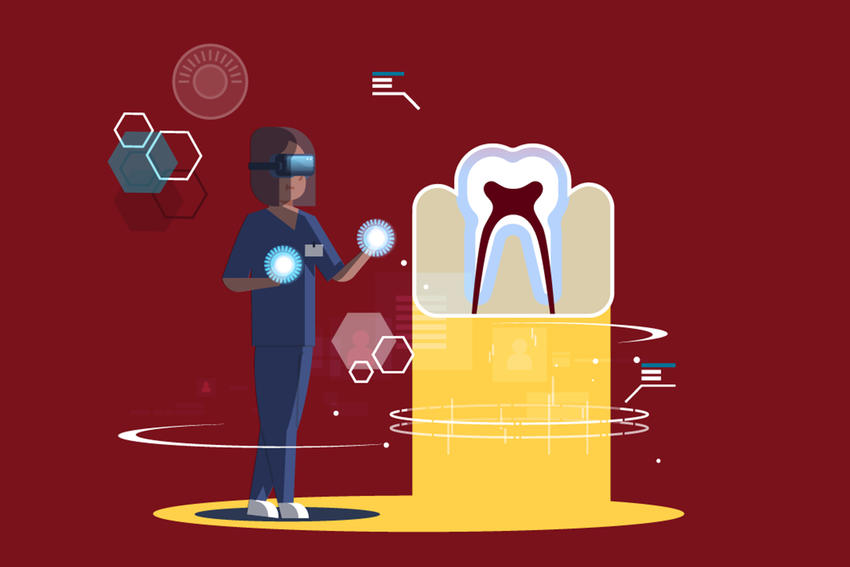Digital Grand Rounds explores virtual reality in education

What can Game of Thrones teach us about dental education? Ahmed Mahrous, DDS, MS, professor of prosthodontics at the University of Iowa, sees a valuable lesson about attention, interest and teaching methods in the series’ success.
The virtual and augmented reality expert explained to attendees of a Digital Grand Rounds presentation on augmented and virtual reality’s use in dentistry and dental education that, contrary to popular belief, millennials’ attention spans are in fact longer than those of other generations. However, due to availability of information and technology, their attention is selective. Using an iceberg model, Mahrous explained that the success of Game of Thrones as a television and book series, despite its high level of complexity, length and number of characters, provides insight into how young people learn.
With Game of Thrones, viewers found an engaging show, which piqued their interest and encouraged them to seek out more information—found in the form of the series of books. Similarly, if lecturers provide engaging and interesting information to their students in class, that lecture will encourage students to do their own research and learn well.
Engaging students, Mahrous explained, happens when we embrace technological advancements and provide visually engaging material. “That’s how I try to teach,” he explained. And that’s what he explained in the first Digital Grand Rounds event of this year’s series, held virtually on January 26.
Now in its fifth year, Digital Grand Rounds is hosted by the school’s Continuing Dental Education and brings professionals together virtually to discuss temporary topics as a community of experts. The series makes up one component of the School of Dentistry’s commitment to continuing education for alumni and the greater community. This year, the series will focus on the role of augmented and virtual reality in the future of oral health.
Kicking off the year’s series, Mahrous shared how he and colleagues at the University of Iowa enhanced the educational experience with models, animated figures and illustrations. “It’s great because in addition to reducing the amount of time I spend explaining subjects, it makes difficult concepts more interesting to students.”
Mahrous and his colleagues tested the use of virtual models of teeth to provide an equitable and accessible course experience, as well as three-dimensional online and print models to demonstrate procedures. Though they found great success and heightened interest in didactic studies, the expertise did not translate to clinical experience.
He determined that the difference came from associative learning, or the process through which multiple stimuli come together to create a lasting memory of an experience. “When you see your first patient, you may feel nervous, you notice the feel of the instruments, the sounds, the smells,” Mahrous explained. “You don’t get that when you read a book or watch a lecture.”
That’s where Mahrous and his colleagues saw augmented and virtual reality coming into play. After providing a brief overview of the history and understanding of virtual and augmented reality, Mahrous explained how and why they could enhance the experience of learning and practicing dentistry.
A new level of immersion, including haptic feedback and telepresence, allows students to fully experience dental concepts and even practice procedures, all without the expense of typodonts. “It’s a field with a lot of potential,” Mahrous explained. “There is a future here.”
Embracing that future, Mahrous and his colleagues tested their own designs of augmented reality headsets and devices that stitched models of teeth, mouths and more. They exposed students to this learning experience, as well as experiences with natural or 3-D printed teeth, and found an increased interest in learning in the virtual format.
“This would have been amazing to have as a D1,” one student reflected in a video Mahrous showed of his students trying augmented reality devices for the first time.
Mahrous is excited to see what happens next, especially with increased investment in virtual reality as the future of mobile technology. He shared ideas for incorporating virtual reality into lectures, pre-clinical practice and even in enhancing dental procedures themselves.
“There is going to be a significant investment in AR and VR,” Mahrous explained. “It will become widely available in the coming years. Embracing that change has the potential to enhance dental education, research and practice.”
Learn more about the Digital Grand Rounds series and other upcoming Continuing Dental Education offerings at smile.umn.edu.